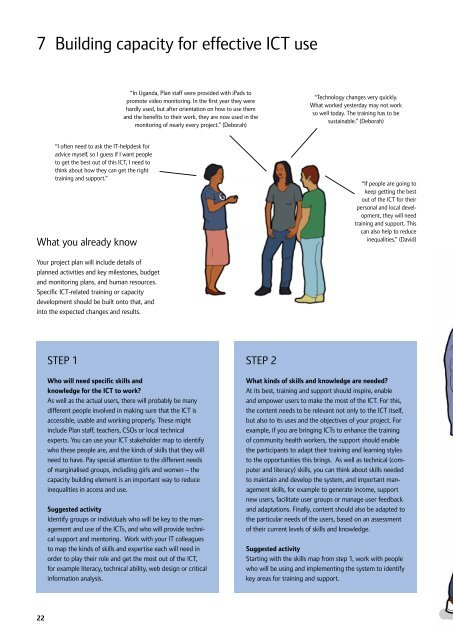nfplyk9
nfplyk9
nfplyk9
Create successful ePaper yourself
Turn your PDF publications into a flip-book with our unique Google optimized e-Paper software.
7 Building capacity for effective ICT use“In Uganda, Plan staff were provided with iPads topromote video monitoring. In the first year they werehardly used, but after orientation on how to use themand the benefits to their work, they are now used in themonitoring of nearly every project.” (Deborah)“Technology changes very quickly.What worked yesterday may not workso well today. The training has to besustainable.” (Deborah)“I often need to ask the IT-helpdesk foradvice myself, so I guess if I want peopleto get the best out of this ICT, I need tothink about how they can get the righttraining and support.”What you already know“If people are going tokeep getting the bestout of the ICT for theirpersonal and local development,they will needtraining and support. Thiscan also help to reduceinequalities.” (David)Your project plan will include details ofplanned activities and key milestones, budgetand monitoring plans, and human resources.Specific ICT-related training or capacitydevelopment should be built onto that, andinto the expected changes and results.STEP 1Who will need specific skills andknowledge for the ICT to work?As well as the actual users, there will probably be manydifferent people involved in making sure that the ICT isaccessible, usable and working properly. These mightinclude Plan staff, teachers, CSOs or local technicalexperts. You can use your ICT stakeholder map to identifywho these people are, and the kinds of skills that they willneed to have. Pay special attention to the different needsof marginalised groups, including girls and women – thecapacity building element is an important way to reduceinequalities in access and use.Suggested activityIdentify groups or individuals who will be key to the managementand use of the ICTs, and who will provide technicalsupport and mentoring. Work with your IT colleaguesto map the kinds of skills and expertise each will need inorder to play their role and get the most out of the ICT,for example literacy, technical ability, web design or criticalinformation analysis.STEP 2What kinds of skills and knowledge are needed?At its best, training and support should inspire, enableand empower users to make the most of the ICT. For this,the content needs to be relevant not only to the ICT itself,but also to its uses and the objectives of your project. Forexample, if you are bringing ICTs to enhance the trainingof community health workers, the support should enablethe participants to adapt their training and learning stylesto the opportunities this brings. As well as technical (computerand literacy) skills, you can think about skills neededto maintain and develop the system, and important managementskills, for example to generate income, supportnew users, facilitate user groups or manage user feedbackand adaptations. Finally, content should also be adapted tothe particular needs of the users, based on an assessmentof their current levels of skills and knowledge.Suggested activityStarting with the skills map from step 1, work with peoplewho will be using and implementing the system to identifykey areas for training and support.22


